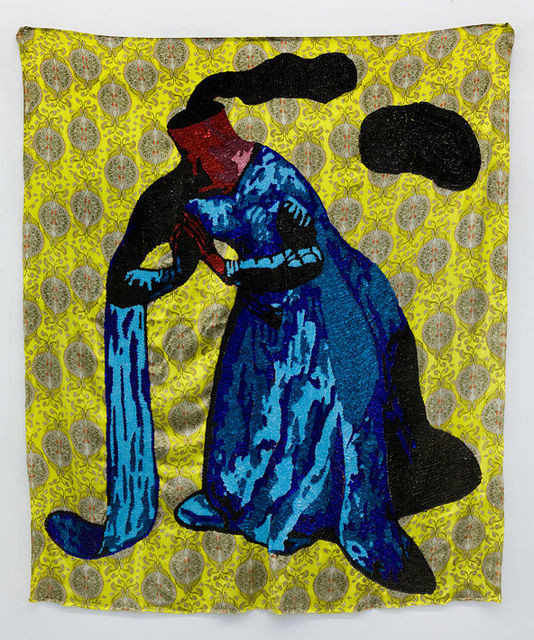Myriam Mechita
21 May - 18 Jun 2011
MYRIAM MECHITA
Les ruines de l'éclat ou la chambre des mystère (My Name Is Nobody)
21 May - 18 June 2011
For all its glitter and sparkle, Myriam Mechita’s magical world has an uneasy, alienating effect. The works presented in the Front Space of Galerie Fons Welters make up a powerful total installation. The legs of slender, deer-like creatures are so sharp that they are more evocative of horns or antlers. The animals lie flailing on the ground or are caught in constraining positions. Although they have been brutally decapitated, you can nonetheless hear their mute cries. The beads flowing like a stream of blood from one of the creatures’ necks presents, together with their sparkling, lacquered ‘hides’, a crude contrast with the visible violence.
As viewers, we seem to be confronted here with a nightmare that has come to an abrupt end. Tables are balanced on one another, and on boards that might serve as rafts. Caught in suspended motion, the elements combine to form a dynamic line. As in a narrative sequence, each island is linked to the next, an action is depicted that might resume at any moment. It remains a mysterious illusion, which defers its final significance in an interim space.
Also exhibited, in conjunction with this sculptural installation, are Mechita’s wallpapers. Embroidered on cloth canvases with colourful, repetitive patterns are holy figures with a plethora of sequins. Divorced from their context, it is the texture of their heavy-looking garments that captures our attention. And just as in Mechita’s sculptures, the head is missing. It is either being consumed by flames or evaporating in a black haze. The scenes are based on Fra Angelico’s Beheading of St Cosmas and St Damian (1438) – a painting in which the figures’ ghastly martyrdom is transfixed in a beautiful image. We are also put in mind of scenes of beheadings depicted by Caravaggio or Gericault. These artists depicted severed heads, while Mechita leaves us with the headless bodies. Like the mythical figure Acephalus, whose headlessness symbolised to the surrealist Georges Bataille liberation from the human form. Mechita emphasises in her turn the incompleteness and bestiality of a human being without a head, without thoughts.
Myriam Mechita (1974, Strasbourg) studied at the École des Arts Décoratifs de Strasbourg. Recent exhibitions of her work include shows at Bloomberg Space (London) and Le Parvis centre d’art contemporain (Tarbes).
[Rosa Juno Streekstra]
Les ruines de l'éclat ou la chambre des mystère (My Name Is Nobody)
21 May - 18 June 2011
For all its glitter and sparkle, Myriam Mechita’s magical world has an uneasy, alienating effect. The works presented in the Front Space of Galerie Fons Welters make up a powerful total installation. The legs of slender, deer-like creatures are so sharp that they are more evocative of horns or antlers. The animals lie flailing on the ground or are caught in constraining positions. Although they have been brutally decapitated, you can nonetheless hear their mute cries. The beads flowing like a stream of blood from one of the creatures’ necks presents, together with their sparkling, lacquered ‘hides’, a crude contrast with the visible violence.
As viewers, we seem to be confronted here with a nightmare that has come to an abrupt end. Tables are balanced on one another, and on boards that might serve as rafts. Caught in suspended motion, the elements combine to form a dynamic line. As in a narrative sequence, each island is linked to the next, an action is depicted that might resume at any moment. It remains a mysterious illusion, which defers its final significance in an interim space.
Also exhibited, in conjunction with this sculptural installation, are Mechita’s wallpapers. Embroidered on cloth canvases with colourful, repetitive patterns are holy figures with a plethora of sequins. Divorced from their context, it is the texture of their heavy-looking garments that captures our attention. And just as in Mechita’s sculptures, the head is missing. It is either being consumed by flames or evaporating in a black haze. The scenes are based on Fra Angelico’s Beheading of St Cosmas and St Damian (1438) – a painting in which the figures’ ghastly martyrdom is transfixed in a beautiful image. We are also put in mind of scenes of beheadings depicted by Caravaggio or Gericault. These artists depicted severed heads, while Mechita leaves us with the headless bodies. Like the mythical figure Acephalus, whose headlessness symbolised to the surrealist Georges Bataille liberation from the human form. Mechita emphasises in her turn the incompleteness and bestiality of a human being without a head, without thoughts.
Myriam Mechita (1974, Strasbourg) studied at the École des Arts Décoratifs de Strasbourg. Recent exhibitions of her work include shows at Bloomberg Space (London) and Le Parvis centre d’art contemporain (Tarbes).
[Rosa Juno Streekstra]

